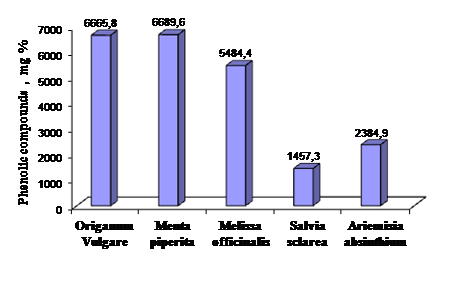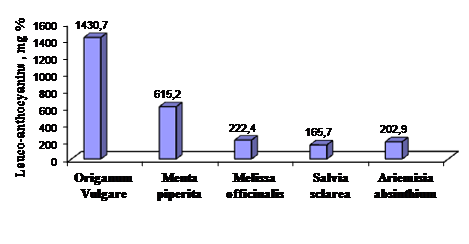Introduction:
Priority direction in the development of food industry is the creation of products for healthy and rational nutrition based on the improvement of existing technologies.
Food products contain a lot of chemical additives in their composition that negatively affect the human body, causing various diseases. To prevent the effects of adverse factors, it is necessary to introduce products containing biologically active substances in their composition to the food ration.
In the recent years, increasing attention is paid to creating products using natural ingredients of plant origin.
The plants synthesize and accumulate a lot of natural compounds belonging to different classes, yet having one common feature — biological activity. Many of these biological active substances possess antioxidant effect — these are phenolic compounds (flavonoids, anthocyanins, phenol-carboxylic acids etc.).
The medicinal plants contain significant amounts of alkaloids, glycosides, vitamins, essential oils, phytoncides, mineral substances, low molecular weight organic acids, proteins and amino acids.
The used in the production of food products from new generation, the different plants can improve the adaptations and the immune capabilities the people. Therefore, in research in this area should attract the attention of scientists and specialists [1, р.272].
All medicinal plants contain phenolic compounds which have a therapeutic effect [2, р.457-465].
The protective effect of the antioxidants is associated with the mechanism of their action. They enter into chemical reactions with the oxidizing free radicals that are constantly formed in the cells, organs and tissues in the process of metabolism and reduce their concentration. To this regard, in the recent years, increasing attention is paid to the search for effective antioxidants sourced from the medicinal plants.
The phenolic compounds, with their diverse chemical structure, are present in all plant tissues, accounting for 2-10% of their mass.
Exposure:
The purpose of this work is, based on biochemical tests to develop natural compositions of medicinal plants with technological purpose, which in the form of additives to various food products, will increase their nutritional value and organoleptic qualities.
The criteria for the development of functional products are medical and biological, technological, methodological and economic criteria. Choosing the right composition and its dosage is the key issue when creating a functional product.
Promissing subjects of modification aiming to form functional properties are homogeneous food systems — basic products such as drinks and sauces.
The idea of enriching food products is promissing and allows to create products containing balanced complex of valuable nutrients in their composition.
Comprehensive research has been carried out on developing new technology for the production of products of functional significance based on medicinal plants. As a result of the work performed five compositions have been developed with added biologically active substances.
Selection has been done in such a way as to provide the following criteria:
- compatibility and obtaining finished product with high nutritional value and high organoleptic indicators;
- enrichment of the product with vitamins and amino acids;
- enrichment of the product with minerals and amino acids.
Depending on what is the technological objective, i.e. what biologically active substances should be added to the food products, various compositions have been developed and added in different percentages of the mass of the enriched product — beverage, concentrate or sauce.
The highest antioxidant effect has the composition containing Menta piperita L. and OriganumVulgare L.
The content of phenolic compounds in the studied medicinal plants oregano (OriganumVulgare L.), mint (Menta piperita L.), lemon balm (Melissa officinalis L.), sage (Salvia sclarea L.) and white wormwood (Ariemisia absinthium L.) are given in Figures 1-3.

Fig.1. Content of phenolic compounds in the tested compositions of medicinal plants phenolic substances
Most phenolic compounds are accumulated in Menta piperita L, followed by OriganumVulgare L., Melissa officinalis L., Ariemisia absinthium L. and Salvia sclarea L.

Fig.2. Content of flavonoids in the tested combinations of medicinal plants
The highest content of flavonoids, among the studied plants, was registered in Menta piperita L., followed by Ariemisia absinthium L., Salvia sclarea L., OriganumVulgare L and Melissa officinalis L.
Fig. 3. Content of leuco — anthocyanins and catechins in the studied compositions of medicinal plants
The highest is the content of leuco-anthocyanins and catechins in OriganumVulgare L., followed by Menta piperita L., Melissa officinalis L, Ariemisia absinthium L. and Salvia sclarea L.
Origanum Vulgare L. contains 0.8 to 1.7% of essential oil, the composition of which includes up to 55% of thymol and carvacrol, up to 15% of sesquiterpen and up to 7% of geranilasetat. The drug contains flavonoids derivatives of luteolin, diosmetin and apigenin.
Menta piperita L. contains up to 4% of essential oil (oleum menthe) in different compositions depending on the variety and climatic conditions in which it has been grown. Peppermint oils contain up to 70% of menthol, up to 25% of which is in ester form. Peppermint oils contain up to 20% menthone.
Melissa officinalis L. contains up to 0.5% of essential oil, up to 70%of which is citral.
Salvia sclarea L. contains up to 2.7% of essential oil, up to 55% of which is thujone, up to 15% — cineole, up to 15% — sesquiterpene and up to 15% — borneol, pinene, tsedren and camphor.
Ariemisia absinthium L. contains up to 2% of essential oils. They contain phellandrene, thujone, chamazulene, cineole and sesquiterpene. Main components of the oil are the thujone alcohol and thujone ketone. The drug has a beneficial effect in stomach cramps and poor indigestion, however it is toxic in larger doses.
Interesting is the development of new compositions from extracted medicinal plants used for enrichment, in the developing of new types of cans.
Key criteria in the selection of the ratio of the recipes components are the chemical composition, nutritional and biological value of raw material and organoleptic evaluation of the finished products. The developed new recipes help to extend the range of products with general and functional purpose.
Targeted combining of ingredients in the recipes ensures obtaining compositions with set chemical composition. The selected ingredients significantly improve the chemical composition of the drinks, concentrates, and sauces, by enrichment with physiologically functional nutrients.
As a result of the studies performed with the obtained compositions, technologies and recipes of enriched drinks, concentrates and vegetable sauces having high nutritional and biological value have been developed. The studied compositions give curative and prophylactic properties to the drinks, concentrates and sauces curative and prophylactic. The resulting enriched products have high organoleptic properties.
The actuality of technological development is in creating recipes for vegetable sauces enriched with the resulting compositions.
Sauces are used in feeding, complementing the chemical composition and taste of the culinary products. The plants contain dietary fibers, including pectin substances, which constitute an unique sorbent capable to put out the body slags.
From a physiological standpoint, the sauces stimulate appetite and lead to the increase the nutritional value, digestibility of the main dishes and to expanding their assortment. They contain essential for the body substances such as digestible carbohydrates, cellulose, vitamins, minerals, and other biologically active substances
The sauce can alter the color, flavor and odour of the finished dishes, making them more vivid, flavoured and delicious. It gives the dishes juiciness, diversifies and complements the taste and increases the nutritional value.
The nutritional and sensory properties of the canned foods depend mainly on the proper selection of the sauces components and the technology for their production.
By improving the processing methods, the natural complex of biologically active substances is preserved and high quality storage performance without preservatives is provided.
The organoleptic and physical and chemical indicators of the finished products were essential when developing drinks, concentrates and sauce.
When compiling the recipes taken into account were organoleptic characteristics such as appearance, color, aroma, taste and texture.
Recipes of drinks and concentrates include forest berries, ithe recipes of sauces — carrots, tomatoes, vegetable marrows and pepper.
Minerals are the structural element of organs and tissues. They make up the enzymes and the cellular and tissue fluid. They participate in the molecular mechanism of muscle contractions and in the process of transmission of nerve impulses, adjust the activity of enzymes and take part in the regulation of acid-alkaline balance and a water-salt exchange.
When preparing extracts, about 90-95% of the mineral substances are extracted and each of the studied medicinal plants can be used to enrich food products with vital elements such as sodium, calcium, potassium, magnesium, zinc, copper.
The plant proteins have advantages over the proteins of animal origin. Te have better water- and oil- retention ability, by forming foam and gel. They serve as binding agents. The protein products of plant origin can improve the technological indicators of quality and enrich the food products with proteins.
The analysis shows that all enriched products have high tasting ratings (average score 9-10) according to the ten-point scale on all organoleptic characteristics, which confirms their high consumer properties.
Based on the results of the study the following conclusions have been made:
- Recipes and technologies for the production of drinks, concentrates and sauces with using combinations of medicinal plants have been developed.
- The regulated quality indicators and their functional orientation have been determined.
- The storage period — 12 months at a temperature of 18 ± 2°C and relative humidity of no more than 75% have been established.
- Technology has been developed for the preparation of plant extracts. Depending on the type and properties of the medicinal plant, the temperature regimes and the duration of the extraction process and the ratio raw material/aqueous extractant have been experimentally determined. Concentration in vacuum of 0,001 MPa and at temperature of 60°C allows to separate the biologically active substances of the plants at a maximum level and to preserve their activity.
- Models have been developed for the production of functional drinks, concentrates and sauces. Technological stages have been determined for introducing concentrated extracts — at the stage of mixing and homogenization, which allows to maintain the micronutrients at the level of 95% to the end of the technological process.
- The analysis shows that all enriched products have high ratings (average score 9-10), according to the ten-point scale, in all organoleptic characteristics, which confirms their high consumer properties.
List literature:
- A.I. Mglinets, Katserikova N.V., The current state of providing the population with food products // Technological and economic aspects of the quality of products and services in trade and public catering: Materials of All-Russian Congress of Trade and public catering.-Kemerovo, 2003. 272 р.
- 2. M.Y.Lovkova, P.N.Buzuk, S.M.Sokolova, N.I.Klementeva, The peculiarity of medicinal plants mechanism (review) // Applied Biochemistry and Microbiology -2001.-T.37, №4, 457-465 p.[schema type=»book» name=»DEVELOPING COMPOSITIONS OF MEDICINAL PLANTS, INTENDED FOR USE AS ADDITIVES TO ENRICH DRINKS, CONCENTRATES AND SAUCES» description=»Studies have been made and natural compositions of medicinal plants with technological purpose developed, which in the form of additives to various food products increase their nutritional value and organoleptic qualities. Promising subjects of modification with the purpose to form functional properties, are homogeneous food systems, basic products such as drinks and sauces.» author=»Georgieva Antoaneta Vassileva» publisher=»Басаранович Екатерина» pubdate=»2016-12-18″ edition=»euroasia-science_28.04.2016_4(25)» ebook=»yes» ]


